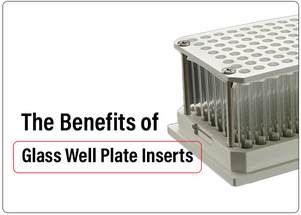Posted by Chrom Tech on 17th Nov 2025
The Benefits of Glass Well Plate Inserts
96-well plates are essential consumables in high-throughput analytical laboratories, particularly those using mass spectrometry workflows. The most common formats—polypropylene 96 deep-well plates in 1 mL round or 2 mL square configurations—offer high capacity and compatibility with automated systems. However, polypropylene can present challenges for certain sample types and solvents. For labs seeking improved chemical compatibility, reduced evaporation, or enhanced recovery, 96-well plates with glass inserts provide a superior alternative.
Improved Precision with Glass Inserts
Traditional polypropylene plates can cause issues in assays with hydrophobic peptides or sensitive analytes, as these compounds may adsorb to plastic surfaces. By using glass inserts within a 96-well format, laboratories can achieve the convenience of a plate system combined with the inert surface and precision of a glass vial.
In one study presented at an MSACL conference, scientists observed that insulin detemir—a hydrophobic peptide with a C14 myristic acid fatty chain—showed declining concentration over time when eluted into plastic collection plates. Switching to glass inserts reduced peptide loss and improved reproducibility, decreasing coefficient of variation (CV) values by more than fivefold to below 10%. (Girtman, et al., MSACL 2019)
Using Glass Inserts for FAME Analysis
Glass inserts are also highly effective for Fatty Acid Methyl Ester (FAME) analysis by GC–MS. When paired with a molded PTFE/silicone sealing liner, these inserts prevent solvent evaporation during extraction or sample concentration steps.
In their published protocol, Williams et al. describe using glass inserts within an aluminum 96-well block. The system includes a PTFE-lined silicone mat and a precision-drilled aluminum cover plate secured with screws. This configuration ensures uniform downward pressure and an airtight seal—minimizing evaporation and maintaining sample integrity. The result is a highly reproducible and automation-friendly setup for quantitative FAME and lipid analysis.
Ease of Use and Automation
Chrom Tech’s glass inserts are pre-packaged in 96-piece plate loaders for simple, contamination-free handling. To load, place the multi-tier base plate over the loader, invert, and all 96 inserts will transfer directly into the plate format. This design supports automated workflows and ensures consistent alignment, making it ideal for robotic systems and high-throughput environments.
Why Choose Chrom Tech 96-Well Glass Insert Plates?
- Improved precision for hydrophobic peptides and low-volume assays.
- Reduced sample loss and adsorption compared to polypropylene.
- Compatible with automation and robotic handling systems.
- Sealable with PTFE/silicone mats to prevent evaporation.
- Designed for reproducibility and long-term durability.
Summary
If you are automating your analytical assays and concerned about sample contact with plastic or solvent evaporation, consider switching to Chrom Tech’s 96-well plates with glass inserts. These innovative systems deliver superior chemical compatibility, precision, and ease of automation. For guidance on integrating these into your workflow, contact our team at support@chromtech.com.
References
- Girtman, A., Grebe, S., Singh, R. “The Challenges Associated with the Development of a Clinically Viable Quantitative Insulin Analog Assay.” MSACL 2019 US. www.msacl.org/view_abstract/MSACL_2019_US.php?id=928.
- Williams, K.J., Bensinger, S.J. (2020) “Cellular Fatty Acid Analysis in Macrophage Using Stable Isotope Labeling.” Methods in Molecular Biology, vol 2184. DOI: 10.1007/978-1-0716-0802-9_4.
Looking for More 96-Well Plate Options?
View the complete lineup of polypropylene, deep-well, glass-insert, and specialty plate formats.
Explore All 96-Well PlatesFrequently Asked Questions About 96-Well Plates with Glass Inserts
Why use glass inserts instead of polypropylene plates?
Glass inserts eliminate peptide or analyte adsorption to plastic surfaces, improving recovery, reproducibility, and assay precision. They are ideal for sensitive assays and hydrophobic molecules that tend to adhere to polypropylene.
Are glass inserts compatible with automation systems?
Yes. Chrom Tech glass inserts are preloaded in 96-piece plate trays and can be easily transferred into multi-tier plate systems for robotic and automated liquid-handling workflows.
Can glass inserts prevent solvent evaporation?
Yes. When sealed with PTFE/silicone mats and secured under an aluminum cover, the inserts maintain airtight conditions that prevent evaporation and protect sample integrity during extraction and analysis.
What sample types benefit most from glass inserts?
Glass inserts are ideal for peptide assays, lipid and FAME analysis, and any method where solvent compatibility or adsorption is a concern. They are particularly beneficial in LC–MS and GC–MS workflows requiring low CV values.

